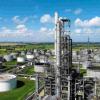We have a packed bed of pall rings in the plant to condense the ammonia vapors with INCOMING liquid ammonia . During shut down whenever the bed is opend, the all pall rings are found to be covered with greasy material. Can this affect the bed performance? Will replacing the bed with new charge will help the matter? The pall rings are dumped randomly during filling. Thanks for your time..
|
|
Packed Bed Query
Started by ASH25320, Oct 03 2006 07:44 PM
3 replies to this topic
Share this topic:
#1

Posted 03 October 2006 - 07:44 PM
#2

Posted 04 October 2006 - 07:23 AM
Ash:
Obviously you must have "greasy" contaminants in your liquid ammonia or in your gaseous stream. All the Pall Rings do is lend area for the intimate contact between liquid and gas so that you can effect a simultaneous heat and mass transfer Unit Operation - very much like an atmospheric cooling tower, except that this operation is the reverse.
The grease coating should not affect the heat and mass transfer - --normally. You haven't stated that it has, so we have to assume it hasn't. Replacing the bed will help the aesthetics; I don't understand what you mean by stating "helping the matter". You've failed to state that there is a problem - other than the aesthetics of seeing "greasy" material on your Pall Rings. Therefore, I fail to see where there is a problem if you haven't suffered any efficiency loss in the condensing of the gaseous ammonia vapors.
If the liquid ammonia has gone through a mechanical refrigeration cycle, I would expect it to have oil contamination - from the compressor lubrication. We also don't know where the gaseous ammonia stream originates and what are its contaminants. You haven't given all the necessary basic data nor identified a problem.
Obviously you must have "greasy" contaminants in your liquid ammonia or in your gaseous stream. All the Pall Rings do is lend area for the intimate contact between liquid and gas so that you can effect a simultaneous heat and mass transfer Unit Operation - very much like an atmospheric cooling tower, except that this operation is the reverse.
The grease coating should not affect the heat and mass transfer - --normally. You haven't stated that it has, so we have to assume it hasn't. Replacing the bed will help the aesthetics; I don't understand what you mean by stating "helping the matter". You've failed to state that there is a problem - other than the aesthetics of seeing "greasy" material on your Pall Rings. Therefore, I fail to see where there is a problem if you haven't suffered any efficiency loss in the condensing of the gaseous ammonia vapors.
If the liquid ammonia has gone through a mechanical refrigeration cycle, I would expect it to have oil contamination - from the compressor lubrication. We also don't know where the gaseous ammonia stream originates and what are its contaminants. You haven't given all the necessary basic data nor identified a problem.
#3

Posted 04 October 2006 - 12:12 PM
Sorry Art I did not define the problem well enough.
Basically the ammonia content varies from time to time from 20 % to 40 % along with inerts, this also causes fluctuating load on downstream scrubber causing ammonia loss to stack. what I meant was does the wettability sort of thing can affect the performance? & how to decide that there is no channeling in the bed|?
Basically the ammonia content varies from time to time from 20 % to 40 % along with inerts, this also causes fluctuating load on downstream scrubber causing ammonia loss to stack. what I meant was does the wettability sort of thing can affect the performance? & how to decide that there is no channeling in the bed|?
#4

Posted 05 October 2006 - 11:11 AM
Ash:
OK. Now I've got a better idea of what may be happening. If you have a steady flowrate of gases to an absorption column, you've met one of the pre-requisites for ensuring that the column's packed bed will operate within desing constraints. Packed beds, as you are probably aware, are very fussy and wil not turn down or up as well as, for example, trayed columns. Packed beds are best when they stay within the confines of the origninal design parameters - both flow rate and concentrations. And when you mention that the concentration can vary as much as twice, then you can start to see that you're pushing the envelope on your packed bed.
You haven't said what is the state of your liquid ammonia, nor what are the temperatures involved. I'll assume it is essentially supercooled liquid NH3 used to condense out the NH3 portion in the gas stream. In condensing the gaseous NH3, you are heating the liquid NH3 and raising its vapor pressure. Since there are inerts in the gas stream, these also have to be cooled, together with the NH3 gas content. The more the inerts, the more gas stream cool down without net NH3 condensation increase - but with more NH3 vaporized as vapor pressure. Depending on the design of the column, you will suffer zones of concentration where you lose a lot of NH3, I believe. You won't get "channeling" effects if you maintain your flowrates constant and steady. Your losses of NH3, I believe, are due to gas composition variations and design constraints of your column. You should study the column calculations and/or simulate the performance based on actual flowrate fluctuations. You should immediately spot the negative effect of NH3 lower concentration in the feed gas. This is an application where a simulation program is a money saver.
I hope this helps explain what I think is happening.
Similar Topics
Packaging And Gas Velocity In Packed ColumnStarted by Guest_ChemEng_CristianoB_* , 25 Jun 2025 |
|

|
||
Multi-Tubular Packed Bed ReactorStarted by Guest_shambola_* , 12 Feb 2025 |
|

|
||
Query For Safety Valve Relief CapacityStarted by Guest_Megh_J_* , 09 Aug 2024 |
|

|
||
Choice Of Model To Packed Bed ReactorStarted by Guest_Kakashi-01_* , 06 Dec 2023 |
|

|
||
Reducing Steam Consumption In Vacuum Packed DistillationStarted by Guest_dpunnn_* , 30 Nov 2023 |
|

|

 FB
FB







